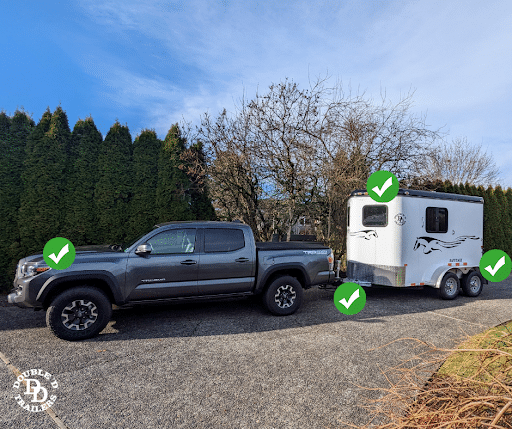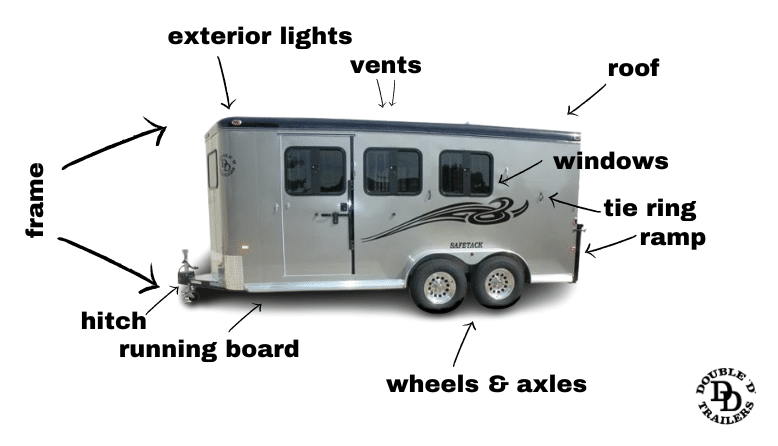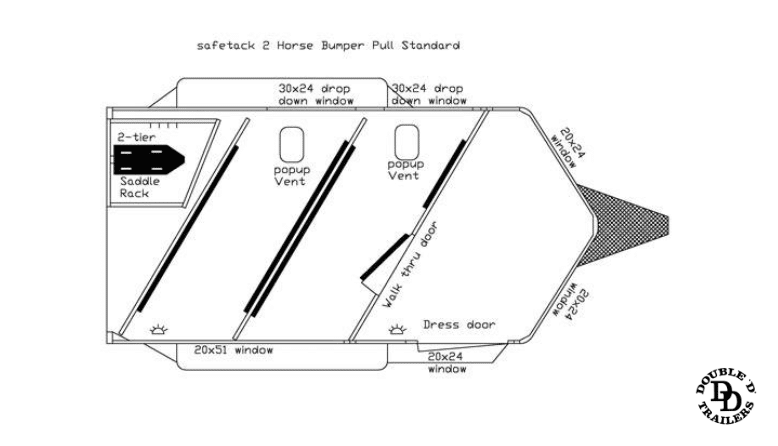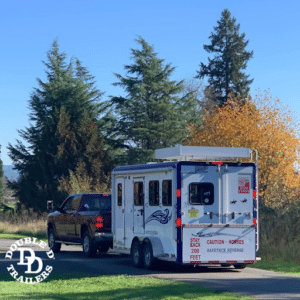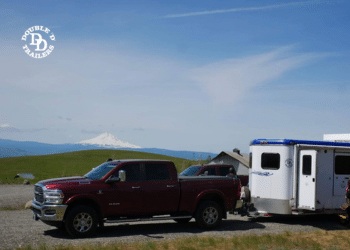The Smart Guide to Bumper Pull Horse Trailers: Features, Parts
It's hard to make an informed buying decision when you’re on the hunt for the ideal bumper pull horse trailer. This quest is full of aspects and nuances to consider to determine the perfect solution for you. We understand this, which is why we’ll cover everything you need to know about bumper pull horse trailers in this full-fledged guide: key features, accessories and parts, and safety considerations. Armed with this information, there’s no stopping you from finding the ultimate bumper pull horse trailer that's tailored to your needs.
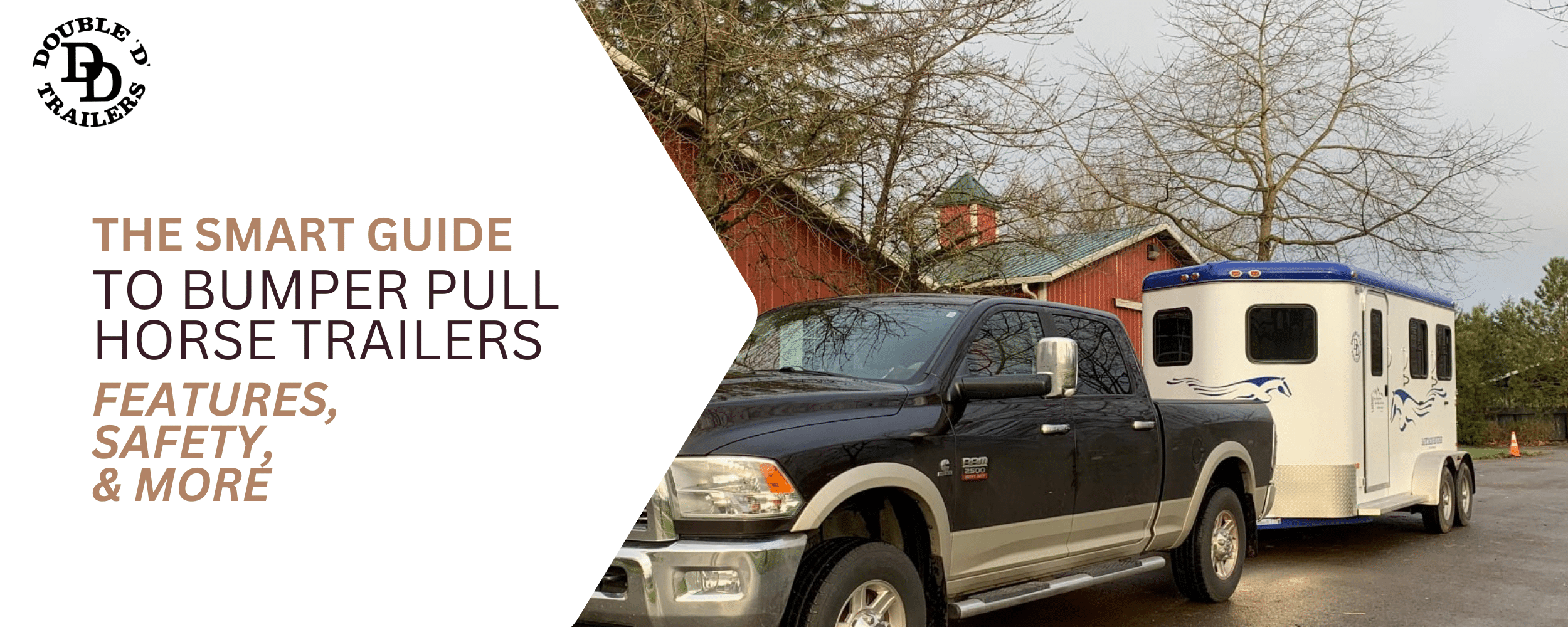
Why Buy a Bumper Pull Horse Trailer?
Ease of use and flexibility in design are the main reasons why horse owners buy a bumper pull horse trailer. This trailer type is also best for those who don't travel long distances and mostly haul one or two horses. As such, the following are additional reasons why you should consider owning a bumper pull horse trailer:
- Affordability and maintenance: In most cases, bumper pull trailers are more affordable compared to gooseneck trailers. Maintenance costs are also lower, which can make a huge difference over the years.
- Versatility: Many 1-horse and 2-horse bumper pull trailers can be towed by a wide range of vehicles, including SUVs and pickup trucks, making them a versatile choice for horse owners who don‘t own a heavy-duty truck or don’t have the budget to purchase one.
- Towing and maneuverability: Bumper pull trailers are easy to tow and maneuver in tight spaces and around corners thanks to their typically more compact size and lower weight compared to goosenecks. If you frequently navigate twisty and narrow roads or you’re new to the horse trailer world, this is the option to choose.
Key Features of Bumper Pull Horse Trailers
The key features of bumper pull horse trailers include its trailer coupler mechanism. It attaches to a trailer hitch bar installed at the back of the tow vehicle via a trailer ball installed on a detachable mount. Also, hitching a bumper pull horse trailer is easier than attaching a gooseneck to a pickup truck.
Other than that, bumper pull trailers share similar components with other horse trailer types: frame, axles, upright structure, roof, ramps and doors, stall dividers, and so forth. Still, bumper pulls offer similar horse area space in a more compact, lighter package that you could tow with your everyday SUV, provided it can handle the payload and tongue weight. In this section, we’ll discuss the key features of BP horse trailers before we move on to a detailed outlook on the parts that this trailer type comprises.
Simple Tow Hitch Design
The frame-mounted hitch design allows bumper pull horse trailers to be practical, easy to hook up to the tow vehicle’s bumper hitch, and versatile. The bumper pull ball hitch connection type is the main difference between BP trailers and goosenecks.
Easy Maneuverability
Thanks to their typically shorter structure and the specifics of the hitch type, bumper pull trailers are easier to tow, especially when you need to maneuver around tight parking lots and narrow streets.
Compact Size and Weight
Most bumper pull horse trailers are designed to carry between 1 and 4 horses: 1-horse and 2-horse models are by far the most popular ones. While providing sufficient room for horses, these trailers are compact and light, which equals a lower Gross Vehicle Weight Rating (GVWR), not to mention that storing such a trailer is easier compared to a large gooseneck model.
Single-Level Design
All bumper pull horse trailers comply with the Horse Transportation Safety Act (an amendment of Title 49 of the US Code). This regulation prohibits the transportation of horses in a 2-level motor vehicle, and all bumper pull horse trailers feature a single-level design.
Towing Vehicle Flexibility
As mentioned above, BP horse trailers can be towed by a myriad of vehicles, as long as they are compatible with the tongue weight and payload of the trailer. For instance, you have a good chance of being able to tow a 1-horse or 2-horse bumper pull behind your daily driven SUV. This eliminates the need for a special tow vehicle.
Affordability
In most cases, a bumper pull horse trailer is less expensive than a gooseneck with a similar horse area size and capacity. This makes BP trailers ideal for horse owners on a budget. As previously noted, they are also easier and cheaper to maintain.
Fuel Efficiency
Depending on the design of a particular bumper pull horse trailer model, it can be more fuel-efficient than other trailer types. A stainless steel front or especially a wedge V-shaped nose can help with reducing drag quite a lot.
Hitch Safety Features
Bumper pull horse trailers usually come equipped with additional coupling features such as safety chains and an emergency breakaway system. The former’s role is to keep the trailer attached to the tow vehicle in case the coupling mechanism fails, and the latter puts the trailer to a stop if the trailer gets detached from the tow vehicle by activating the electric braking system.
What are the Different Parts of a Bumper Pull Horse Trailer?
To better understand what bumper pull horse trailers can offer and how they function, you need to know their key areas and parts in detail. This is how you’ll know what to look for and where to guide your attention when comparing different models, not to mention that it will help you set priorities and outline preferable components when ordering a custom trailer or purchasing one in stock.
I. Exterior Parts
The exterior design of a bumper pull horse trailer comprises several parts and sections responsible for its appeal, but these parts’ primary function is to keep both horses and humans onboard safe from the elements and prevent them from getting injured if involved in an accident.
Frame
The frame is a horse trailer’s backbone, therefore, it should be sturdy, yet flexible, and not too heavy. It should also be protected from rust or oxidation, depending on the material used for it. Most bumper trailers today come with steel frames, but there are better solutions, such as the Z-Frame technology by Double D Trailers. It utilizes zinc and chromate to create an alloy that’s stronger than steel, but lighter and more durable.
Axles
The axles of a BP horse trailer carry its weight and are responsible for its performance while on the road. The axles need to be adequately calculated based on the trailer’s GVWR. Weak axles would compromise road safety, but so would heavy-duty ones that are installed on a relatively lightweight trailer.
Wheels
The wheels and trailers of a bumper pull horse trailer should be compliant with the rig’s GVWR as well, and they must also be properly inflated. Tire pressure can have a substantial effect on the trailer’s handling and braking.
Roof System
A BP horse trailer’s roof plays a key role in the structure of the unit. It affects the center of gravity and is directly responsible for the trailer’s insulation and accident safety. Therefore, it needs to be flexible, yet strong, and not conduct heat. Composite one-piece roofs such as Double D Trailers’ SafeBump solution allow for impressive structural stability and boast excellent insulation qualities, not to mention that such a design eliminates the risk of leaks and keeps horses safe in case they decide to test the rigidity of the roof using their heads.
LED Trailer Lights
Modern LED lighting solutions should be used throughout the trailer because of their efficiency, long life, and brightness. Both exterior and interior lights can benefit from this technology. A BP horse trailer needs to be equipped with sufficient illumination inside, as horses despite being stuck in dark areas for too long. When ordering a new trailer or updating an existing one, make sure every stall is well-lit, and add loading/unloading lights as well. You can even opt for illuminated outside handles, which is always a nice touch.
Electric Trailer Brake Kit
Electric brakes on a bumper pull horse trailer can be the difference between avoiding an accident and not having anything to do to avoid it. This is an essential safety feature that not all BP models come with, so you’re strongly advised to not miss adding it as a primary safety feature.
Feed Doors
Installing feed doors on your existing trailer or having them installed while building your custom rig is important. It will allow your horses to have a snack without having to open the trailer’s door. It’s best to install durable feed doors with strong hinges and a flush design for extra safety. StateWide Windows offer plenty of time-tested products that always get the job done.
Horse Trailer Ramp
Many bumper pull trailers come with step-up entry options, meaning that horses need to step inside rather than walk on a ramp. The latter is usually a preferable choice, as it enhances loading and unloading. There are half-width ramps (typically used for narrow trailer doors) and full-width ramps which are safer and easier to use. It’s important for the ramp to be strong enough to endure frequent use and to have a non-slip surface.
Roof Vents and Horse Trailer Metal Vents
Proper ventilation is crucial for the comfort and well-being of your horses during transportation. Even well-insulated trailers need roof vents. Some designs (such as the Flettner roof ventilator) allow for adequate airflow by extracting hot air and fumes from the inside and bringing in fresh outside air. This also prevents condensation, which is harmful to almost any trailer in the long run.
Tie Rings
Tie rings are essential for securing your horses and keeping them where you need them to be. When constantly moving inside, horses can disrupt weight distribution and cause dangerous situations, not to mention that they can get hurt. Therefore, strong, properly secured tie rings installed inside the horse area and on the outside of the trailer are a must.
Trailer Tie System
Using trailer ties, you can prevent your horse from turning around while inside the stall and thus save the animal from getting injured. For the exterior part of the trailer, you can use a Hi-Tie system instead of classic trailer rings and ties. It’s an extended arm that allows more movement for the horse while still keeping it firmly tied to the trailer.
Running Boards
Bumper pull trailer running boards enhance the rig’s design, but they are all about practicality. Having one-piece, full-length running boards enhances usability by helping you easily check out what your horses are doing insight and sometimes allowing you to enter the trailer more easily.
Slider Window For Trailers
Slider windows with separate bars and built-in screens are some of the best additions to a bumper pull horse trailer’s exterior. They provide more natural light inside the horse trailer, which horses appreciate. Additionally, being able to keep them open thanks to drop-down screens is important for enhancing airflow.
Trailer Fenders
Trailer fenders and mud flaps have more than just a decorative function. They protect the trailer from the elements by not allowing debris and mud to pile up on its sides, thus enhancing its maintenance and appearance at the same time. In the long run, fenders contribute to the trailer’s longevity. They need to be strong enough, yet lightweight.
Horse Trailer Hitch Covers
Horse trailer hitch covers are among the accessories that often get neglected. For a small amount of money, you can purchase a protective cover and use it when the trailer is parked, which is most of the time. The cover will slow down the aging process of all hitch components, which ultimately positively affects safety.
Water Caddy
Water caddies, tanks, and bucket bags are essential for your horses’ well-being on the road. During your frequent stops, you can use either of these features and accessories to keep the horses properly hydrated, especially when on a long trip.
II. Interior Parts
The interior parts of a bumper pull horse trailer have everything to do with the comfort and safety of horses and humans. All such parts should combine these key aspects with other factors such as longevity, practicality, convenience, and price.
Horse Dividers
Horse dividers keep horses separated from one another, but they have other functions as well. They should be designed to protect horses from injuries. For instance, a horse could easily get a leg stuck inside a badly designed divider, which could lead to a fracture. The best horse divider should keep horses separated and thus prevent them from confronting each other, but it should also not block their vision and allow for enough head movement. If you have the chance, load your horse into the trailer you intend to buy (or an identical one) and see if there’s enough room and comfort.
Rubber Floor Mats
Rubber floor mats are essential for any horse trailer. They provide extra grip and thus eliminate slippery surfaces that could easily result in injuries. Additionally, floor mats could improve comfort by reducing road noise and providing extra insulation. If the trailer floor is made from aluminum, perfectly fitted floor mats will prevent it from corrosion, as horse urine and other contaminants lead to oxidation. Last, but not least: rubber mats help with regular maintenance, as they’re a lot easier to clean.
Saddle Rack
Saddle and bridle racks are invaluable when it comes to storing saddles, bridles, and other equipment. They are designed to organize everything in a neat, secure, and space-saving way, which means you won’t have to worry about damaging anything during transportation. The best saddle rack models you could opt for are foldable, so you can put them out of the way when not used and utilize the full tack room space you have at your disposal.
Tack Room
Tack rooms are most often placed in the back of bumper pull trailers and provide a separate space where you can keep your tack and gear and make sure they’re always in pristine condition. A tack room is what you need to keep everything organized, not to mention that you’ll have access to your equipment without bothering the horses. One of the best solutions is the SafeTack system, exclusive to Double D Trailers models. It’s a swing-out tack room that adds practicality to the trailer and makes it a lot safer and usable by removing rear door obstructions when needed.
Padded Stall Dividers and Walls
Padded stall dividers and interior walls increase comfort and improve safety by providing extra insulation and preventing your horses from getting scraped or bruised during loading, unloading, and transportation. When you opt for such a feature, make sure the material used for the pads is easy to clean.
Latch Dividers
Installing latches on the stall dividers allows you to lock and unlock the latter when needed. This is a seemingly small, but crucial addition when it comes to road safety. Such dividers are a lot less likely to snap out of place.
Understanding Bumper Pull Horse Trailer Weight: Why It's Important
The key to safely towing a bumper pull horse trailer is to have the right vehicle for the job and to understand how weight distribution, payload, and tongue weight affect performance, braking, and handling.
On average, a 2-horse bumper pull trailer weighs between 2,400 lbs and 3,200 lbs, but it largely depends on the make, model, and equipment (a dressing room, for instance, can increase the weight by 800 lbs). Still, you need to add the weight of your horses and all your equipment to calculate the GVWR. Don’t forget about CGVWR (Combined Gross Vehicle Weight Rating) as well. This indicates the maximum weight of a fully loaded trailer and towing vehicle specified by the manufacturer.
What You Need to Know About GVWR and Curb Weight
GVWR (Gross Vehicle Weight Rating) stands for the full weight of your trailer, including optional equipment, cargo, and passengers. The curb weight of a trailer only includes its own weight and the standard features and equipment it comes with.
How to Calculate the Tongue Weight on a Bumper Pull Horse Trailer
It’s fairly easy to calculate a bumper pull trailer’s tongue weight. The input data you need is the trailer’s weight, the length of its shell, and the distance between the back of the trailer and the center of the axles. Double D Trailers’ tongue weight calculator can get the math done in seconds. Axle placement and weight distribution play a key role in tongue weight. The axles should be precisely mounted to avoid a heavy nose, but also a heavy tail, which would cause the trailer to sway instead of increasing the tongue weight.
Bumper Pull Horse Trailer Weights
Not all trailers weigh the same, even if you’re comparing two identical models in terms of dimensions and capacity. Weight can vary depending on fabrication methods, materials, and especially equipment. Let’s focus on a few randomly chosen examples:
1-horse bumper pull trailers
| Make & Model | Curb Weight (lbs.) |
|---|---|
| Double D Trailers | 2,700 |
| Equispirit | 2,780 |
| Shadow | 2,040 |
2-horse bumper pull trailers
| Make & Model | Curb Weight (lbs.) |
|---|---|
| Double D Trailers | 3,420 |
| Maverick | 2,900 |
| WW | 2,300 |
3-horse bumper pull trailers
| Make & Model | Curb Weight (lbs.) |
|---|---|
| Double D Trailers | 4,140 |
| Logan Coach | 2,920 |
| Featherlite | 4,000 |
What are the Typical Sizes and Dimensions of Bumper Pull Horse Trailers?
It has already become apparent that the combination of length and axle placement plays a key role in a trailer’s performance and handling when combined with weight distribution. Here’s what the typical dimensions of a 1-horse or 2-horse bumper pull trailer look like.
| Horse Trailer Type | Width | Horse Area Length | Total Length | Height |
|---|---|---|---|---|
| Straight Load Bumper Pull | 6 ft | 10 ft | 14-15 ft | 7.4 - 7.6 ft |
| Slant Load Bumper Pull | 6 ft | 11 ft | 15-16 ft | 7.6 - 7.8 ft |
Important Safety Features to Look for in a Bumper Pull Horse Trailer
We’ve already gone through some of the important features for bumper pull horse trailer safety, such as hitch chains, breakaway systems, padded interior walls and dividers, and non-slip floor mats. But there are more
Sway Control Bars
Depending on the tow vehicle’s towing bar and the trailer coupler, you could opt for a sway control bar. It’s a simple, yet effective system that prevents the trailer from violently swaying and potentially jack-knifing into your tow vehicle, or even worse – rolling over.
Reinforced Frame and Flooring
Strong floor and frame equal longevity and ability to handle frequent stress from loading and coping with bad roads. Therefore, opting for a reinforced frame structure and sturdy floors is crucial. You need to choose wisely when it comes to materials and fabrication quality. Again, the Z-Frame technology is one of the best solutions: it’s light, flexible, doesn’t crack when exposed to stress, and is rust-resistant.
Anti-Lock Braking System (ABS)
ABS was invented by FIAT in the 70s and has been factory-installed in passenger cars since the early 80s, but it was introduced to trailers in the late 90s. Having a horse trailer equipped with ABS would enhance its stability by preventing the wheels from locking during emergency braking.
Emergency Exit
Emergency exits are important in case of accidents when the trailer is flipped on its side or its main entry/exit point is damaged. Also, emergency exit doors allow you to enter the horse area fast without having to open the main doors or lower the ramp. Therefore, opting for such an exit is a must.
Reflective Decals and Tape
It only takes a split second to prevent an accident sometimes, hence the availability of reflective tape and decals. They make the trailer visible from a further distance, allowing others to notice it earlier.
Camera Systems
Being able to monitor your horses during transportation is beneficial, as you will be able to spot if a horse doesn’t feel well or turns inside the stall and moves around, which can be dangerous.
Safety Glass on Windows
Except for having bars and screens on trailer windows, you could also opt for safety glass. In case of an accident, it shatters into tiny, less harmful bits, which could prevent serious or even fatal injuries to your horses.
Wheel Chocks and Jacks
A jiffy jack and a set of wheel chocks are part of the essential equipment of any bumper pull horse trailer. You will need them when you’re forced to replace a flat tire, but wheel chocks are also handy when the trailer is parked and you want to make sure that it’s secured in place, especially during loading and unloading.
Can Bumper Pull Horse Trailers Accommodate a Living Quarters Area?
Yes, they can, but it might not be a good idea in most cases. 1-horse bumper pull trailers with living quarters are a working solution, but if you need to haul two or more horses and need space to dine, sleep, and shower, then you’re better off choosing a gooseneck model. Living quarters bumper pull horse trailers for two or more horses are unsafe because of their extreme tongue weight and the possible weight distribution issues their layouts cause. You can find detailed information about the dangers of larger bumper pull horse trailers with living quarters here.
What is the Best Bumper Pull Horse Trailer on the Market?
The best bumper pull horse trailer is the one that boasts unparalleled safety, comfort, handling, custom features, and plenty of technological advancements that affect all key areas. Double D Trailers’ SafeTack 2 Horse Slant Load Bumper Pull Trailer ticks all the boxes:
- Lightweight structure: This 2-horse model comes with a spacious dressing room, tack room, and storage space, but only weighs a tad over 3,400 lbs.
- Strength and durability: The patented Z-Frame technology guarantees flexibility, longevity, and excellent rust resistance.
- Customizable horse area: You can customize the horse space dimensions, including height, and you can choose between forward-facing or reverse configurations.
- SafeTack technology: The SafeTack load design features a swing-out tack compartment, allowing for full and safe access to the back of the trailer.
- Safe horse area: The trailer comes with a composite, one-piece SafeBump roof, SafeKick wall system, and an optional side ramp.
Bumper Pull Horse Trailer: Expert Insights
A common misconception among buyers is that gooseneck trailers are safer than bumper pulls. In reality, towing safety issues with bumper pull horse trailers most often come from choosing inadequately equipped or underrated tow vehicles. A bumper pull being towed behind an adequately equipped tow vehicle is just as safe as a gooseneck horse trailer.
Thinking that a bumper pull can be towed by any tow vehicle that has a bumper hitch is far from the truth. When it comes to tow vehicles, a load is only as strong as the weakest link. Automobile dealerships are the worst source of information when it comes to bumper pull safety and towing, as dealers often focus on the really large towing capacity number primarily. For example, if an SUV can tow 9,000 lbs. and you want to tow a 6,000 lbs trailer, the dealer would tell you about the power of the engine and transmission and often brag about the tow rating. There’s a problem, though: the 9,000 lbs number isn't the weakest link in the tow equation; it’s the tongue weight rating that is dependent upon payload. An SUV that can tow 9,000 lbs would have a tongue weight rating of around 800-900 lbs. tops. Most Warmblood size 2-horse bumper pull trailers in a reverse load configuration will have a tongue weight of 1,100 lbs or greater, thus overloading such a vehicle is very possible.
Another misconception is that lighter trailers are safer, but it’s the exact opposite. In many cases, lower weight equals lower quality due to cost savings on materials. This is a recipe for disaster in emergencies.
When it comes to proper bumper pull trailer hitching, there is a common problem that should be addressed: some people roll the tongue down on 'top' of the ball and clamp, which most often results in an unhitched trailer. If the trailer is connected properly, it can't become disconnected, unless a component breaks.
In terms of general safety, the most appropriate and versatile model is the Safetack Reverse 2-horse bumper pull. Horses tend to haul with less stress in a rear-facing configuration, and this model has the option of hauling forward, and/or reverse facing the rear.
Ready to Hitch Up? Make Your Bumper Pull Choice with Confidence!
With this smart guide, deciding to buy a bumper pull horse trailer is no longer a tedious task. You now know how to:
- Choose the right bumper pull horse trailer size
- Identify the advantages of bumper pull horse trailers
- Recognize all exterior and interior parts and their functions
- Understand the differences between GVWR, curb weight, and tongue weight
The next step? Compare bumper pull horse trailer prices. Or, start designing the bumper pull horse trailer of your dreams.
Choose Your Bumper Pull Horse Trailer!
